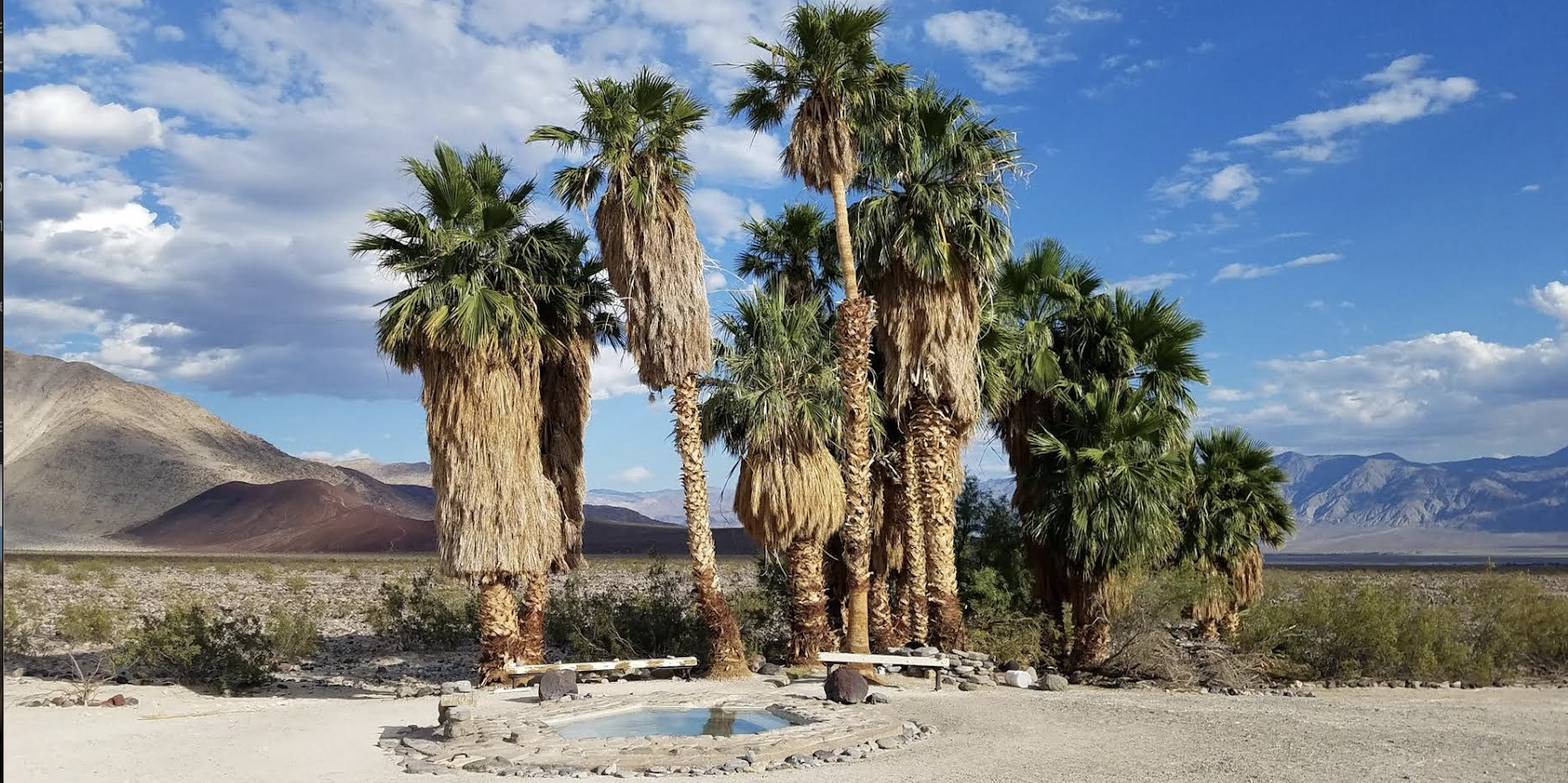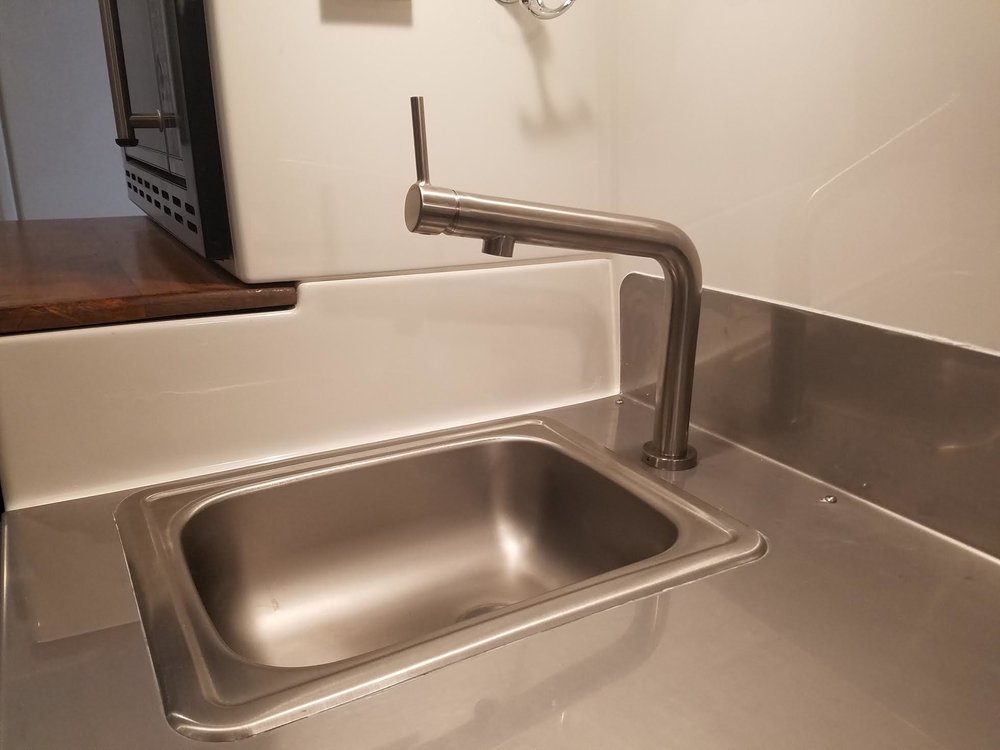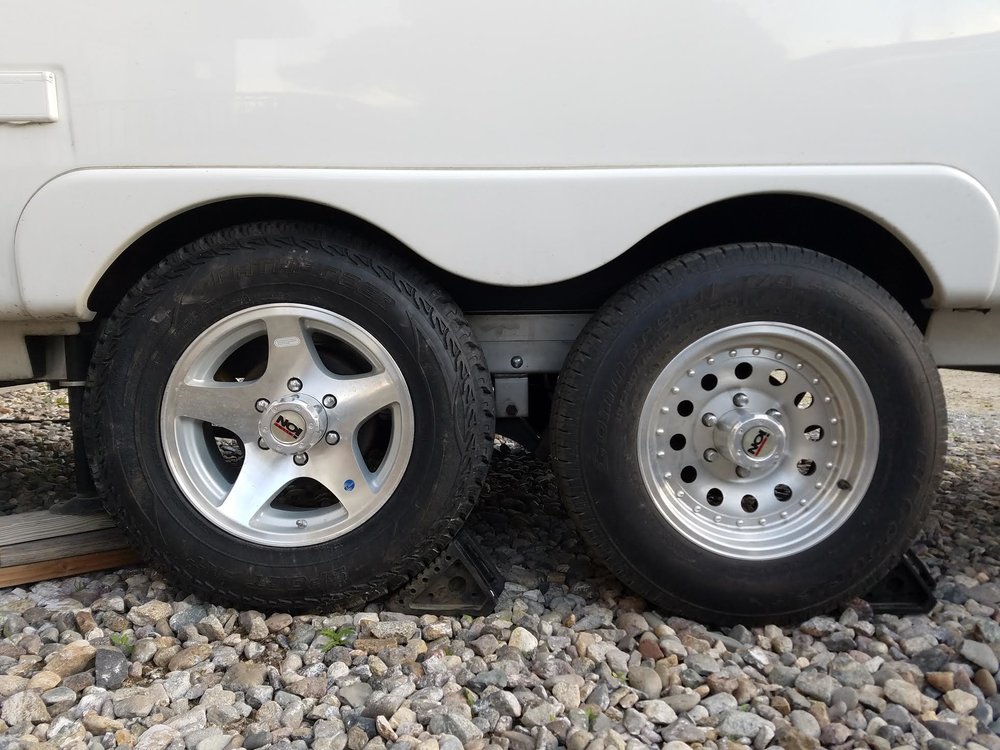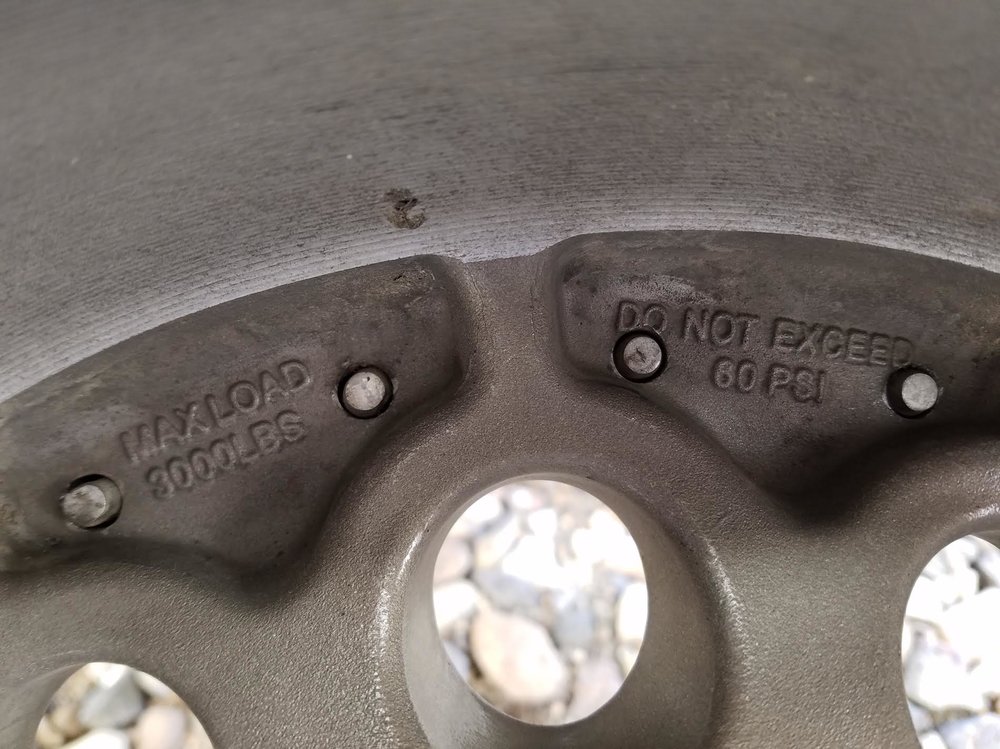-
Posts
666 -
Joined
-
Last visited
-
Days Won
45
Everything posted by Raspy
-
Just installed this nice faucet we found at IKEA. Easy to reach handle (right in front and on top) and it splashes less on the counter.
-

What's your tow vehicle, it's tow weight rating & what are you towing?
Raspy replied to StoicJim's topic in Towing an Oliver
Overland, If I understand you correctly, you'll be getting an F150 Raptor. Is that right? Nice trucks. What engine will you choose? From what I've read the 2.7 is very capable and fun to drive while getting great mileage, unloaded. The 3.5 looks better on paper for towing, maybe, but uses more fuel and is slower. The V8 naturally aspirated is simpler and cheaper, I think, with only a small mileage penalty. I Know the turboed engines will run on regular, but the performance will be down. The V8 might actually do better in real world towing of an Ollie on regular fuel. And it might be more reliable in the long run. The 5.4 was the one that was blowing out spark plugs if I remember correctly. I'm sure that is fixed by now. Thoughts? Oh yeah, can you order the new 10 speed yet? Can't imagine why a truck needs a 10 speed auto, but maybe. -
I'm pondering the 60 PSI thing too. That is plenty adequate for the load, but it should be noted to prevent someone from going to 80 psi and then driving on a hot day to where they hit 90 PSI. I bolted on a one of my new Star wheels, rated at 3200 lbs and I like them. A better wheel I think. But they sit 1/2" inboard compared to the stock wheel (1/2" more backspacing). A bit closer to the shock, but better as far as the fender goes. Only a small difference. Maverick: good to know you have hull 93. We may have to compare notes sometime. Do you have the Commercial TA tires too?
-
Here is some info from the wheels on Hull #92. I'm assuming they are ION wheels and I found T62 on them.
-

What's your tow vehicle, it's tow weight rating & what are you towing?
Raspy replied to StoicJim's topic in Towing an Oliver
Fortunately, or unfortunately for me, I need a strong truck for other reasons. I have a number of other work trailers and I travel through the Sierra all the time. So having one to tow my Ollie is a bonus. I also need clearance and 4WD because I like to get way out into the desert when I can. I'm on my third Cummins and each one has been way better than the last. A '93, then a 2004 and now a 2014. I have put nearly 500,000 miles on the three of them. I'm a huge fan of the simple Cummins design, it's proven reliability and the way it sounds while working. The other weaknesses in the truck kept me moving towards later models, but I had to skip the 2009 through 2012 to avoid their problems. The 2014, in spite of being much more complicated and possibly expensive to maintain, is worth it, so far. Unfortunately, deleting it is not a viable option with the Aisin tranny. Yet. The third gen Rams (2003 to 2008) are good trucks too, but never were fully ironed out. So you have to figure in some upgrades to make them, and keep them great. Like so many things, its a trade off. If I was going to just go down to Mexico and kick around for a couple of years, I'd get a 1997 or 1998 12 valve with a stick and call it a day. Absolute reliability and a much better body than a first gen. For use around here a new 2500 with coil rear springs and a G56 stick seems good. Or an Ecodiesel 1500 if the EPA allows them to be sold again. I Know, I know, it's not a Cummins. Reed, with his Bluetec Mercedes made a very good choice too. As Overland mentioned, a pickup is very good for a TV with all of it's space. Mine seems just about full whenever we go. Maybe stuff we really don't have to have, but nice to have. Lots of firewood, folding chairs, and outside camp stove, bikes, generator, etc. I'm of the ilk these days that trips should be comfortable and fun, with lots of toys. -
Just as a follow-up on the ION wheels. I pulled one off this morning and looked at it. Here are some interesting specs: Model T-62, 16 X 7, with zero offset Load rating 3000 lbs Max pressure 60 PSI. So, we can't run the load range E tires to their maximum of 80 PSI. The zero offset number is important if going with the 16X7 size to clear the shocks on the rear and stay well within the fender on the front. The load rating is higher than shown in the specs that were linked in John's first post.
-

What's your tow vehicle, it's tow weight rating & what are you towing?
Raspy replied to StoicJim's topic in Towing an Oliver
I would never suggest that you have to "get" something the way I might, and I'm not upset. Not claiming I have some inside information. Just saying that the towing experience with a diesel is something you may not be able to decide on paper. This is because of the driving character. That character is noticed through driving them while towing. Many don't have experience with them and therefore don't appreciate the advantages they offer. So if it's just monetary savings on paper, that value is lost and diesels look like a bad investment. I agree with your thoughts on the compromises and the various models to suit different uses. Does your spreadsheet show those compromises? It may not pan out to wait 8 years for the breakeven on cost. Who knows what fuel will cost, the reliability of current models, etc. It's been the case that a number of engine models have had serious problems over the last eight years, for instance. So those calcs, eight years ago, could have led to disappointment. That is where brand loyalty can adversely affect the decision, and again, it may not show up on paper. Nobody knows how that will play out in the future. My personal preference is to spend more up front and pay less as I go. Just my own method. Your mileage may vary. -

What's your tow vehicle, it's tow weight rating & what are you towing?
Raspy replied to StoicJim's topic in Towing an Oliver
Using a spreadsheet to compare diesel to gas powered vehicles really misses the point. It's true that diesels cost more to buy and service. And the new ones have much more complicated emissions equipment, but the appeal is the lower cost to drive on trips and, this is the big one, they tow much better. I can't imagine justifying a diesel with a projected breakeven of 8 years out. Way too many variables. I'm very glad I paid the extra for my Ram diesel, but it mainly shows up in towing ability and cost savings on fuel while on trips. The spreadsheet says nothing about the ability of the vehicle and the ease and pleasure of using it while towing. You might also have some other needs for a truck that could play into the decision. The point is, you either get what a diesel is, or you don't and it doesn't matter. If you've never had the pleasure of towing with one, it's hard to factor in the added initial cost as an argument for buying one. Then, you should also look at the reliability of some models. This is very important and not mentioned in your analysis. Mainly with diesels, but gas engines too. And it might lead to looking at pickup brands other than Ford. -
-
I posted about this earlier, but here is the fix I came up with for mine. A couple of the doors were popping open while traveling. You can feel the ones that are weak by carefully pulling on the latch. If they open as soon as the latch moves, rather than having to pull the handle most of the way, they will likely open on the road. I used a small piece of plastic cut from an extra venetian blind slat. My thickness is 1/8" The catch is held on with two screws and nuts. The screws are not long enough to add the spacers, so you'll have to get longer ones as part of the fix. After fixing two of them, a third one fell open on the last trip. So I guess I should have done them all. Noether of the ones with spacers have opened while traveling. Easy and effective fix.
-
I'm surprised to hear that Oliver changed the brand of wheels, but the increased strength makes sense. Especially since they were recently putting 5200 lb axles in. I noticed that Reed had no rivets on his wheels and I do. Was wondering what that was about. I may install my set of Star wheels I previously mentioned. Rated at 3200 lbs. http://www.trailer-wheels.com/16x7-HiSpec-Series-04-Aluminum-Star-Trailer-Wheel-6-Lug-3200-lb-Max-Load_p_722.html#.WQ9zBKOZORs
-
I think you're overthinking this. Steelies are also heavier and the finish will have to have maintenance too. I doubt anyone has had trouble wth the aluminum wheels. Remember, The 3500 lb axles are only rated at 1,750 lbs per side. So, in theory, the wheels are already stronger than the axles. Of course, the axles will take much more than that in real world conditions. Reed's wheels don't have the fake rivets, so not sure which ones you'll actually get. I just bought a set of (6) Star Wheels for another trailer, see link, from my supplier for $50. each. They are rated for 3,200 lbs each. IMHO, they look better and are lighter than the steelies, while being plenty strong. You could go with those if you wanted a stronger design, but like aluminum vs steel. https://www.etrailer.com/Tires-and-Wheels/HWT/TTWAL04167655.html
-
You might be happier with a washing machine tub. They come in stainless and porcelain. Can be had for nothing and work very well for campfires and barbequing. Doubtful anyone would steel it.
-
Mine has a "furnace" setting. I've never seen it try to go to AC on that setting, but maybe that's because I've never used it while plugged in. Although it clearly says "furnace" as one of it's modes. I wonder if maybe its the heat strip that comes on when plugged in, instead of the furnace? If so, it would run the AC fan and look like it was trying to cool. Dunno. I'll try it at home and get to the bottom of this. For now, and while unplugged, try the Furnace setting and set the temp. If you use the auto on the fan switch it might go full blast when not needed. Try low if you have it.
-

Siphoning water & deep inside the storage compartment -
Raspy replied to KarenLukens's topic in Mechanical & Technical Tips
Reed, Pumping it in really does make more sense than pouring or syphoning. And after seeing yours in operation, I see how easy it is. An excellent system for when we are not connected to pressure water. Good job Oliver! -
Yes. I set my fan on low to keep the noise down. Your choice on that. Make sure the propane is on and set the temp on the thermostat to about 68. After an hour or so you can adjust it up or down to suit your comfort. It will come on and blow warmed air out of the lower vents and in the bath. Make sure the vents are open. This works just like a forced air heater in a house. The control is the same and the heat is the same. You'll find that after the initial run, it will settle down and not run very much during the night. After a while you'll find the setting that suits you best. I've also found that our Ollie is so air tight that I like to leave a window cracked just to get a bit of fresh air. You can also leave the bathroom upper vent pushed up and open.
-
John, We don't have a built in inverter. So we plug in a small 100 watt inverter into the cigarette lighter. It's an inverter. I've been using these little ones and large inverters on my boat for many years and am very familiar with them. You are right, it's not the most efficient way to charge something, but all we have for our Apple computers are the 120 volt chargers. And since they are already plugged into the small inverter, I also plug my tiny 120 to USB converter too. And then plug my phone into that. If nothing else is being charged, I plug my USB into the on-board stereo USB port or my Ram's USB port. Overall, the little inverter has less standby losses than a 3000 watt inverter, and it's what we have, so it works more efficiently than starting the generator, for instance, or plugging into the Ram's 110 volt outlet and leaving the computer out there until it's charged. Not trying to say there is no more efficient way to make power, just looking at the practicality of it and the scale of it and yes it is a good way to do it.
-
George, While on battery power just use the 120 volts from the inverter sparingly and watch the battery voltage to keep an eye on it. You'll probably just run the microwave a for a minute or two to warm something up now and then. When you are done with the inverter, like after breakfast for instance, shut it off. It doesn't make any difference wether you are "on solar" or not as to what you run on the inverter, or at least not enough to worry about. Consider the solar to be a battery charger. The batteries carry the heavy demand of the inverter and do it regardless of the sun. You might hold off on running the microwave until the solar has had all day to catch up, but what if you want the microwave for breakfast duty? Like in your car, you fill the tank at one time and you drive it at another time. The batteries are the gas tank. Just monitor the charge level of the batteries and consider all the ways to keep them charged. It would be nice if you could live within the power from the solar, but don't count on it with all of the variables of power usage, weather and shading. We have a small, cigarette lighter style inverter that we use to charge phones and computers. These are cheap and easily available at auto parts stores or camping supply stores. They work really well in the tow vehicle too, while underway. To check Ollie's batteries, let them rest for a while after a load and then check their voltage. You probably should not run them down below 12.3 when rested. Checking them while using them does not give an accurate reading. You can preserve a lot of power by heating water on the stove instead of in the microwave, for instance. Run the fridge on propane unless you are plugged in. Don't try to run the heat strip, electric heater, electric coffee maker or other 120 volt appliances from the inverter. Just short term loads like a minute or two in the microwave, or run a power tool. We have the T105 batteries and I'm pretty careless with my 12 volt consumption. LED lights in the Ollie are very efficient, so we leave the courtesy lights on all night. We watch movies in the evening and we charge the computers/phones whenever we want with the small cigarette lighter inverter. Then if we get low after a couple of days, I run the 2000 watt generator for an hour or so. It's a perfect match for the on-board charger. So, try not to let the rested voltage go below 12.3. You will see 12.3 while the batteries are under load, and that is OK. Charge with the generator plugged in until you see 14.2. Rested full charge is about 12.65. That means they were brought up to 14.2 and then removed from the charger and rested. When plugged in, the batteries will come up to 14.2 and then go to a "float" charge that will carry loads and protect the batteries from overcharging. That will be 13.2 or 13.5. With a glance at the battery monitor you can tell just what is going on. If you have solar and are parked in the sun, you will see the voltage climb during the day if you are not taking more out than the sun is putting in. A rough guide is to look at the batteries you got in your Ollie and figure out how many amp/hours they are. For example, if they are 300 amp hours total, you could draw 1 amp for 300 hours, or 10 amps for 30 hours. But since you don't want to draw them down below 50%, cut those numbers in half. And the faster yo draw it out the less you get overall. If you wanted 1200 watts at 120 volts from the inverter, an approximate microwave load, you would be pulling about 11 times the amperage from the batteries as you are delivering at 120 volts to an appliance. 1200 watts at 120 volts is 10 amps at 120 volts. Eleven times that, at the battery, would be 110 amps. So you can see that if you could only draw 50% of 300 total amp hours from your batteries you only have 150 available. One hour on the microwave would be all they could do. Especially since you get less total amps, the faster you draw them. You probably won't run the microwave for an hour, but think about an electric heater that you might want on all night. No way it will work. Or you might run the microwave for 15 minutes, an electric coffee maker for 15 minutes, a hair dryer for 15 minutes and an electric heater for 15 minutes and the batteries are at the 50% mark or lower. Done, until you re-charge. So use the inverter sparingly until you get the feel of it. Some typical 120 volt loads might be: Microwave 1000-1400 watts. I think Ollie's have 1400 watt units Electric heater 750 watts on low and 1500 on high Hair dryer approx. 1200-1500 watts electric coffee maker approx. 1200 watts Computer and phone chargers are very small loads of about 50 watts or so. Not sure just what mine are, but we can charge a phone and the computer for less than 100 watts. All of those 120 volt loads pull 11 times the amps on 12 volts from the batteries. A 10 amp 120 volt load (1200 watts) takes about 11 times as many amps from the battery at 12 volts, or 110 amps. If your batteries were 220 amp hour rated, they would be at or below 50% in one hour. But since that is a heavy load, they would probably be done in about 45 minutes. You can look up battery load charts and see the relationship of load and time. So, the bottom line is: just be careful until you get the hang of it. leave the inverter off until you want to use it. Use propane for the fridge and heat. Watch your battery monitor and think about what it is telling you. Don't run the batteries down below 50% or so which is about 12.3 volts rested. Since the solar won't work at night and you probably don't want to run the genny at night, head into the evening with enough charge to run the lights, watch a movie and charge your computer or phone, until morning. You might even settle into a routine where you run the genny, if the solar was poor that day, in the evening to pop the voltage up to 14.2 while making dinner and using the microwave a bit. Then you will have plenty for the night to run the heating fan with propane heat, run the lights, etc. If you are at 12.4 and all you want to do is a bit of reading, that would be fine to run an LED reading light all night.
-
We had a great time in Yosemite and thank you Reed for helping us get set up! Excellent tour and good times around the campfire. I would never have guessed that we could just show up and get a prime camping site! Thanks again. Yosemite was memorable with the big waterfalls raging and small ones trickling down everywhere. Mirror Lake actually a lake again. Liye had never been and it's been a long time for me. See you guys in Bandon, John and Liye
-

Siphoning water & deep inside the storage compartment -
Raspy replied to KarenLukens's topic in Mechanical & Technical Tips
If someone wanted to be able to syphon water in, you could replace the factory check valve on the fill line with a ball valve. Then you'd open the ball valve to syphon and close it to pressurize the system. Or you could open it to use the onboard pump to suck the water in and then close it. -
Yvonne, Wait a minute! 2 Axles will be enough???? Doesn't your TV have two axles too? (I'd add a smiley, but I don't know how!)
-
I've had a couple of my cabinet doors open while traveling too. But it wasn't the hinge screws, it was the catch. The catch just barely caught the strike plate and would open from movement. The fix is to space the strike plate down with a small spacer, made of plastic or something. I had a left over plastic slat from a venetian blind that I cut mine from. You may need longer screws with nuts. About 1/8" will fix it and give the catch more bite. Once the door is open while driving it will likely over stress the hinges and I think that is when your damage occurred. Check all of the doors and look for ones that are not securely caught.
-

Lodging around Howenwald and westward: recommendations please
Raspy replied to John E Davies's topic in General Discussion
Can't recommend a place, as I didn't order mine, but you know John, we are going to need a full report! What an exciting trip! Have fun! -
I camped as a kid, with my parents, in a tent and then a tent trailer. Later I just took my pickup or Blazer and went to the desert. I finally figured out that sleeping on the ground, in 20 degree weather, wasn't very much fun. One night, near Death Valley, my daughter and I arrived during a cold relentless wind. Snow on the ground had come down days before and never melted. It blew like dust as we drove. It became clear that this was going to be an interesting night. And we were only at two axles. But a friend at the campsite asked us if we'd like to spend the night in a his friends trailer to get out of the wind. Yes! He let us in. It was just a little 50's or 60's sticky about 15 feet long. Perfect. As the wind whistled and the trailer gently rocked, I decided that this was the thing to have. So, three axles was on the horizon for me. But I still didn't want to tow. I tried the camper shell and the pop-up route for a while. Stuck at two axles for the ability to get farther back in. I've always liked the way tandem axles pull. Stable and less likely to drag their frames on rough roads. Plus they are prepared to carry more weight, if needed, like lots of firewood, a dirt bike, gas cans, water. All the extra things that make a casual trip fun. I'm not a back packer and I don't try to travel as light as possible. And I like the remote desert environment where it takes hours on dirt roads to get there. Spend a week and enjoy the ambiance. Bring some fun things along. Find comical comfort in a harsh environment. Now, I've settled on an Elite ll as the best compromise for my wife and I. The quad can go in the pickup, if I decide to bring it at all. The Ollie has excellent towing manners. Reasonably back road capable. Extremely convenient in so many ways. Comfortable without being big. We can leave it behind and explore in the truck. I think I've reached my axle limit. Four. Three would do it, but all the things that come with four are worth it to me. The fun we have over the years with our camping hobby, the interaction with family, new sights and experiences, matures or changes with time. I've had lots of fun with minimal gear in the past, as a kid, or on spur of the moment trips. The change in equipment to a more luxurious and convenient arrangement over the years doesn't make the trips more fun than they used to be long ago, but it makes them more suit what I want now. For instance, I've always been amazed at the desert views and mysteries. The extreme difference in how time works there, the solitude, the timeless and unchanging nature of the place. Even though it is all formed by violent storms, earthquakes, volcanos and plate tectonics. I've marveled at it on hikes and while blasting along at speed on dirt bikes. Power sliding around a big sweeper, on the pipe, steering with the throttle, there is still time to notice the terrain, the vegetation and the vastness of it all. Now, as that era fades into the past, I'm thrilled to have more conveniences as I explore it in a quieter way and ponder it's magnitude. Yep. Four axles will be fine thank you. That is, unless you count the quad's two axles riding in the back of the truck!
-

Yamaha EF2400iSHC Brushless Inverter AC Generator
Raspy replied to rideandfly's topic in General Discussion
I want to see how reliably, if at all, the AC will run on the Easy Start and a 2000 watt generator. I already have the 2000 watt Yamaha. It may be OK, provided there are no other loads, but the battery charger will also be drawing power unless the batteries are completely charged. There is also the problem of lower generator output at higher elevations. About 3% per 1000 ft. if I remember correctly. I'm designing my inverter system to have a 3000 watt inverter (6000 watt surge) using an inverter that I already have. With a manual transfer switch it seems I could set the switch to position 1 and supply all 120 volt power to Ollie from the inverter. At the same time the generator could be plugged in and charging the batteries, but no 120 volt power would feed on through from the converter/charger to Ollie. The on-board charger would simply be charging the batteries. This would allow a 6000 watt surge to start the AC and allow the generator to charge the batteries through the onboard battery charger. The effect is, the batteries would buffer the output of the generator and allow a huge starting load. Then the genny could catch up on the charging before the next start cycle. The onboard charger, at full output, doesn't overload the generator. As long as the average charging amps met the average AC load, the system would run fine. There are some inefficiencies. The inverter is only about 90% efficient and the charger has some waste of unknown percentage. Plus the batteries have losses during charging. But it might work and adapt the smaller genny to the larger, intermittant load, even at altitude. Then position 2 on the transfer switch would be for normal shore tie duty and take the inverter out of the circuit. Thoughts?









